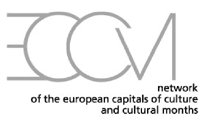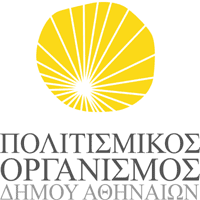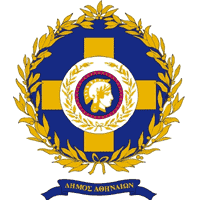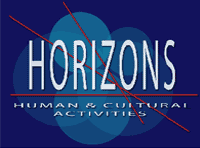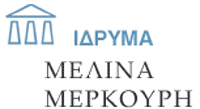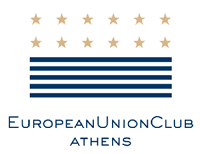Cultural Policy
Thursday Oct 18th - 9.30 -11.00
Chair Person: Spyros Mercouris -General Coordinator of Athens European Cultural Capital 1985
Speakers of the session on Cultural Policy
"Cultural Policy of the Municipality of Athens"

Sofi Daskalaki Mitilinaiou - President of the Board of the Cultural Centre of the Municipality of Athens
(Image: Sofi Dasklaki Mitilinaiou stands at the right with sunglasses amongst children from 108 Primary School in Athens.)
further contents - CV
Speech
Culture constitutes for us, in the municipality of Athens, a fundamental priority and central axis, upon which we work for the quality of life in Athens.We view culture, not only with its narrow sense, but from a wider point of view, that covers a lot of aspects of daily life and contributes substantially in the prosperity of our fellow citizens.
For this aim the official institution that designs and realises the cultural policy of the municipality, the Cultural Organisation of Municipality of Athens, is converted in order to serve concrete objectives for a solid result: to offer qualitative and multiple cultural stimuli to all the citizens of Athens.Culture should not be the privilege of the few.
Culture should be addressed to all. The Mission of the Organisation is to approach all those that for either economic, social or educational reasons, are excluded from all sorts of cultural activities whether that is entertainment, education, or a simple exposure to the arts.
At the same time, it is of at most importance to invest in you, supplementing and enriching the social education and experiences offering new stimuli, and extending the significance of culture so that it includes the challenges but also the opportunities of modern times.
In order to achieve our objectives, the Cultural Organisation of Municipality of Athens is formed around four axes:
- The first axis perceives culture both as an element of entertainment and the promotion of the cultural level of the citizens.
- The second axis is the aspect of culture promoting social education in fields such as training people more sensitive to environmental issues, introducing massively the use of new technologies etc.
- The third axis is cited to the culture as a component of international prestige, promoting the international role of Athens. Within this framework the Cultural Organization Municipality of Athens inaugurates the “Documentation Center on Capitals of Culture”, after the end of the Symposium.
- Finally, the Cultural Organisation functions as a cultural umbrella, strengthening initiatives and movements that materialise in Athens by individuals and institutions.
Our philosophy in the Cultural Organisation is depicted in our redesigned brand which uses as an icon a sun. A sun brilliant, Athenian, a sun - symbol of god Apollo, the mythological god of arts. A sun that shines for all of us, as precisely does the culture that we illustrate it’s for all of us, for each one of us, without discriminations and exceptions. A sun that lits up our lives exactly as the culture that we aspire to conquer. A sun that reminds us of the past, where we were inspired and that leads our steps to the future that we imagine.
"Cultural Policy, the Arts, Vision, Productivity and Quality of Life"
Michael D. Higgins - former Minister of Culture, Ireland and MP of Irish Parliament
further contents - CV
Introductory Statement for the discussion on Cultural Policy by Michael D. Higgins:
“There is one story – the neo-liberal economic one. In its time it will allow cultural manifestations for the diversification and titillation of its leaders. It may even construct in cities and events a bogus nostalgia that abuses memory, that ransacks the cultural heritage for potential of commodification. All manifestations of the cultural are, of course, selective, are politically charged, are aspects of control, subversion, liberation. The moment of creation is a moment of artistic power, however, and the Left has to accept t hat it may arise at the point of consumption as well as production. The act of selection discrimination is a creative choice. All reproduction, distribution, mass consumption, follows the logic of capital. It is in the act of origination that most creative power is located.”
hat it may arise at the point of consumption as well as production. The act of selection discrimination is a creative choice. All reproduction, distribution, mass consumption, follows the logic of capital. It is in the act of origination that most creative power is located.”
- Michael D. Higgins, “One Response or a Multitude of Stories – Creative Society or Knowledge Economy? Issues for the Cultural Space in an era of Globalisation.” Speech given at the Day of Culture 2000.
Resume of his speech given at the Symposium
Cultural policy should in his opinion stay focused on creating 'cultural space' which the arts and the people need for their creativity and creative expressions. There is a danger that everything is being consumed by a consumer society with the arts and culture becoming commodified products while the 'cultural space' vanishes. Hence criticism is not enough. Moreover, it should be kept in mind that the cultural space is wider than the economic space. Moreover the cultural space stretches further back in time but to heed this, it will require three things:
- ethics of remembering
- integrity of freedom
- realization as to what cannot yet be imagined, but which people want to share
All three factors combine to constitute the public world. Here is where the most important thoughts are articulated. But the public world is under threat by privatization. The odd thing is that there prevails insecurity of the private while it can be observed that out of this insecurity there develops the tendency to claim ownership in private over things which would otherwise be shared in public. As a poet Michael D. Higgins would even admit there comes a moment when we have nothing to share.
However, he sees that possession replaces trust in public spaces. Still, there is nothing abstract about this problem.
He went on citing a practical example of Toronto subscribing itself to a 'creative cities strategy' with a poet writing the preamble. What makes a city to flourish? That question can be answered by noting that today's classes are the various divides and not merely the digital one. There is a great difference when it comes to participating in culture with higher incomes tending to attend more concerts while middle class income recipients going more into the cinema.
Altogether the present poses a serious challenge in following ways:
- social and cultural exclusion
- exploitation of those who wish to capture a place in the market
- cultural goods become general commodities
He wonders where is then still 'creativity' without such commercial undertone?
The requirement for public spaces goes with the need for integration and social inclusion. Still, the increase in number of people working in the socalled cultural or creative industries indicates that there is also an increasing risk to destroy the very space they need to be creative. New York has, for example, gone through quite a regression in recent years. It can come to a point when people cannot afford it any longer to live there and work. As a matter of fact ever more people live to work and not work to live. That reflects the kind of economy as it has become the established norm of today.
At political level, there has been very little response coming from the Parliaments both at European and at national level to the report "In from the Margin" outlining the need to uphold a creative diversity. By heading towards a knowledge economy, there is the added risk of reductionism with emphasis being placed on acquiring mere technical skills or in terms of communication and information only multi media capacities. At the same time, society tends to reduce citizens to mere consumers going silent although they could tell many interesting stories.
Michael D. Higgins emphasizes that there is a need for re-evaluation. To do that there has to exist an ethical base for another type of discussion about culture and cultural policy. This calls for recognition of the public space.
"Continuity of EU Cultural Policy: Istanbul 2010 - a European Cultural City already in dialogue"

Nuri M. Colakoglu - Coordinator of Istanbul 2010
further contents - CV
Resume
The uniqueness of Istanbul 2010 is that it started out from creating a NGO and therefore represents a bottom-up process until the designation to be a European Capital of Culture besides Pecs, Hungary and Essen, Germany in 2010 was given.
To understand the various layers of history as evident in a city like Istanbul it should be reminded that there Hellenism, Byzantine, Ottoman and modern Turkey all of which have left their own unique imprint and which are still influencing how the city views itself in terms of history.
In terms of the complexities and problems to be faced in the present, the key question is how these problems can be overcome with the help of culture. Istanbul wants to set here an example. It can be done best by being a grass root, bottom up movement to allow for the participation of everyone.
Istanbul is a city of poetry and philosophy with many outstanding scholars and poets having created the basis for the approach adopted for 2010. In particular Aximander's definition of the four key elements, namely air, earth, water and fire shall be used to adopt the cultural program accordingly.
The Capital of Culture in Istanbul will not focus merely on the centre, but as well on the poor districts. Moreover it is the aim to involve the youth studying in 28 universities which exist in Istanbul. It gives an idea of the dimensions involved.
"Children’s Imagination, the truth of the world – the experience of Kids' Guernica"
 Takuya Kaneda, Prof. of Art Education, Tokyo
Takuya Kaneda, Prof. of Art Education, Tokyofurther contents - CV
Speech
I am very happy to come to Athens again and it is a great honor to attend such a meaningful symposium. I am really wondering how and why I could come to Greece three times within two years. Last year in April I participated in a Kids' Guernica peace event in Crete and again in Chios this past May and now I am again in Athens. There must be something like a magnetic power to bring me to Greece so frequently in such a short period. I guess this is the power of richness of Greek culture.
My first visit to Greece was in 1975, more than thirty years ago, during my student time; even now I remember very well the moment when I stood just in front of the statue of Poseidon at the National Archaelogical Museum of Athens. I was so impressed by the statue of Poseidon, created 2500 years ago; its perfect form and proportion. It showed me that the artistic skill could not be surpassed, not even after 2500 years. What could we develop in these years? Airplanes? Computers? The Internet? But not such a beautiful sculpture.
After Greece I traveled to Turkey, Iran and Afghanistan. In the Kabul Museum in Afghanistan, I was again attracted by the Gandhara statues, the beautiful harmony of Buddha's peaceful philosophy and Greek craftsmanship of sculpture; the wonderful harmony of the East and the West. Then I returned to Japan and again found Greek influence in Japanese Buddhist sculptures in the ancient temples. I noticed that the image of Hercules reached Japan as one of Buddhist deities.
It means Greek culture reached Japan over 1000 years ago, through Persia, Afghanistan, India and China. Of course, there were no airplanes or e-mails at that time.
This travel during my student time taught me a lot about the meaning of culture and history.
The span of two thousand years is nothing for human progress. What could we learn from such history? It was the beginning of my life work.
Richness of culture spreads over vast distances even in the ancient times.
Culture is always been influencing another culture and transformed into a new culture.
One more important point:
Peace is essential to enrich cultures.
For example, Alexander the Great applied a policy of fusion and it initiated the period of Hellenism. Even though conflicts continued, the Gandhara art flourished during the peaceful time of this Hellenistic age. Needless to say, peace is essential to enrich the quality of culture while war is always destroying cultures.
As to Kids' Guernica and the imagination of children
Kids’ Guernica emphasizes dialogue among different cultures in order to foster peace consciousness amongst children and young people. The aim is to create a peaceful culture.
This Kids’ Guernica Children’s Peace Mural Project was inspired by Pablo Picasso’s Guernica, a painting made during the Spanish Civil War. In 1937, Picasso created his masterpiece against the brutality invoked upon the town of Guernica.
This project is based on a very simple principle, namely children in different parts of the world create a peace painting on a huge canvas the same size as Picasso’s famous Guernica (7,8 x 3,5 m).
Already more than 120 peace paintings have been completed in 40 different countries.
The Kids’ Guernica peace painting on a huge canvas is not exactly a mural but it might be called a movable mural. Murals are usually painted on walls, but a wall is a symbol of separation just like the Berlin Wall. However, the Kids’ Guernica movable murals, streaming in fresh air, indicate as metaphor the wish of children to remove all separations between nations, races, religions, cultures and people.
This project started in 1995, on the fiftieth anniversary of end of World War II. After Picasso’s Guernica, seventy years have already passed, but the world is not free from conflict and violence but still full of terror and sorrow.
Since I got involved in this Kids’ Guernica project, the participant children’s imagination expressed in their peace paintings has always given me a hope for the future. Imagination is a source of all creative arts and always enriches cultures. Imagination doesn’t mean merely a fancy dream but it is also to imagine others’ pain and sorrow, in a different word; imagination based on the reality of the world can become a power to change it.
Through the process of making peace paintings, children are thinking about the actual situation of today’s world: the truth of the world, and looking for what they have to do for the future. This is the beginning of love for other children in different places of the world. And it is also dialogue among different cultures; to observe and appreciate peace paintings created by children of different cultures is to share other children’s perception and imagination on peace. Especially, it is very important to know how children wish peace in a conflict area such as Afghanistan.
Imagination is the same as having a dream. Art is always giving a dream to people. A Pacifist is often criticized as an idealist but world peace cannot be achieved without the ideal. Idealizing requires imagination. To realize a dream, creativity becomes necessary. Artistic creativity can embody a dream. Creativity is a power to transform an imaginative vision into a new reality. Such imagination and creativity are also required to build a peaceful world.
This project emphasizes the necessity of collaboration to let an imaginative vision become a reality. The collaboration is not only ‘amongst children’ but also ‘between children and adults’ and ‘amongst different cultures.’
Kids’ Guernica is not individual art work but participant children have to work together to complete their huge peace painting.
European Union - Agenda for Culture
Reference: Communication for a European agenda for culture in a globalizing world
“Culture and creativity are important drivers for personal development, social cohesion and economic growth. Today's strategy promoting intercultural understanding confirms culture's place at the heart of our policies,” said José Manuel Barroso, President of the European Commission, on 10 May 2007.
On the same day, the Commission adopted an important strategy document on culture in the form of a Communication, which proposes a European agenda for culture in a globalizing world.
Objectives for a European agenda
The agenda has three sets of objectives:
- to promote cultural diversity and intercultural dialogue in Europe;
- to promote culture as a catalyst for creativity and innovation in the context of the Lisbon Strategy for jobs and growth. Indeed, the culture and creative sectors – television, cinema, music, performing arts, entertainment, etc. – in the EU generated €654 billion in 2003 (2.6% of the Union’s GDP);
- to ensure that culture becomes a key component in the EU’s external relations so as to build bridges with other parts of the world. In this context, the Commission is proposing the creation of an EU-ACP (African, Caribbean and Pacific Countries) Cultural Fund to support the distribution of ACP cultural goods.
A structured and flexible framework
The new strategy proposes a co-operative approach between the Commission and Member States which is both structured and flexible. This Open Method of Coordination, which has been used successfully in other policy areas, involves agreeing common objectives and regularly following up progress towards them.
The Commission has also suggested that a Cultural Forum should be created for consulting stakeholders.
Website: http://ec.europa.eu/culture/eac/communication/comm_en.html
« The ECCM-Network Symposium and The Kids' Guernica Exhibition in 2007 | The Role of Culture »


